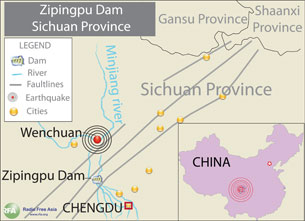>>> View larger map
HONG KONG--The earthquake that devastated the southwestern Chinese province of Sichuan on May 12, 2008 could have been triggered by hydroelectric power projects in the area, experts say.
Fan Xiao, chief engineer in the seismology team at the Sichuan provincial land and mining bureau, said in a May 22 interview in a Guangzhou newspaper that dams along the Minjiang river and at Zipingpu had created reservoirs on top of a key fault line in the earth's crust.
Yang Yong, a research colleague of Fan's, called on experts to investigate the issue further.
"My view is pretty much the same as Fan Xiao's," Yang said. "Before the quake happened, we had raised a whole series of issues with hydropower construction projects, especially the dams along the Minjiang river valley and at Zipingpu."
"It's internationally accepted that reservoirs play a part in triggering earthquakes."
"With regard to Zipingpu, the connection to the Wenchuan earthquake needs further confirmation from other seismologists," Yang said.
'Spreading rumors'
Fan Xiao first cautioned about the potential danger of the Zipingpu dam in the Nov. 2004 issue of China National Geography. After the May earthquake last year, he revisited the issue in the June 2008 issue of the same magazine. He and the magazine were both subsequently criticized in the Chinese media for "spreading rumors" based on "speculations."
But the Jan. 16, 2009, issue of Science magazine carried an article by Richard A. Kerr and Richard Stone that gave more credibility to Fan's theory by suggesting a similar link.
"The first researchers have gone public with evidence which stresses that water piled up behind the new Zipingpu Dam may have triggered the failure of the nearby fault," the magazine said in a summary on its Web site.
According to the Guangzhou-based Southern Metropolis Daily, Fan Xiao pointed out after the earthquake that the dam at Zipingpu had been built along a fault line, leaving a reservoir more than 100 meters deep.
Fan said that pressure from the water had contributed to the break-up of the earth's crust along the fault line. The water would also have acted as a lubricant between the two sides of the fault line, he suggested, a claim that has been made by other international seismology experts.
Call for research
Yang said that many more dams have been built, or are being built, on fault lines in southwest China.
He called for further research to prevent similar tragedies from occurring.
"The May 12 earthquake is actually a really good opportunity for us to investigate in depth this issue of human activities along fault lines," Yang said.
"We shouldn't deny the link between reservoirs and earthquakes just because certain vested interests are involved or because it shows up some mistakes made by the government," he added.
Reservoir-triggered seismicity is the term used by experts to describe the triggering of earthquakes by the physical processes that accompany the filling of large reservoirs.
Harsh K. Gupta, a top international expert on the subject, defined this in 2002 as "earthquakes occurring in the vicinity of artificial water reservoirs as a consequence of impoundment [i.e., the collection and confining of water]."
According to Gupta, more than 90 earthquakes are known to have been triggered by the filling of water reservoirs, including the 1967 Koyna earthquake in India, which measured 6.3 on the Richter scale.
While not all engineers accept his views, the independent U.S. Commission on Large Dams has recommended that the link between dams and quakes should be considered for reservoirs deeper than 80-100 meters.
Sichuan-based environmental activist Yang Xudong said development has come rapidly to the remote, mountainous regions of the province, with scant heed paid to environmental consequences.
"The opening up of the Minjiang region brought a lot of economic activity to the area, but the ordinary people got very little out of it," he said.
"Flood prevention work was below standard, because no single organization would take responsibility for it. There was no attempt to balance environmental, climate change, green belt, or ecological strategies, including wildlife habitat."
Original reporting in Mandarin by He Ping. Mandarin service director: Jennifer Chou.
Experts Speak up about Quake Cause
Scientists warn of further disasters as dam reservoirs are blamed for the May 2008 Sichuan earthquake. Their voices are finally being heard.

Map showing locations of fault lines, dams, and earthquakes in Sichuan.